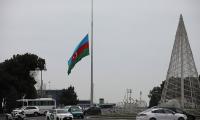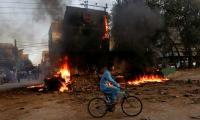Saeeda Gazdar’s short stories are not all about politics and repression; some are full of nostalgia and recall the pre-partition days. Her story ‘Hindustani, Pakistani’ is one such story that begins in London where a Pakistani man Ahmed and an Indian woman Najma meet after a long time.
They had studied together decades ago and now they recall their good old days as students in London when they were all Indians; Pakistan had just come into being. Ahmed had come from India to London but now his family had migrated to Pakistan. He had offers from Karachi University to teach but Najma wants him to go back to India with her and start a career there. They hear on the radio that the political situation in Pakistan is volatile with agitation all around. Ahmed wants Najma to move with him to Pakistan.
In flashback, Ahmed recalls his landing at Karachi port. Four years ago, he had left Bombay for London as an Indian citizen and now he was approaching Karachi in the newly created Pakistan. After joining the University of Karachi, the first objection that he receives from one of his colleagues is why he says Adaab rather than Salaam. This conversation displays an early divergence of ideas in Pakistan that ultimately led to the Khuda Haafiz discussion. The university colleague insists that Adaab was used to address Hindus but now we have a Muslim-majority country of our own where we should not use Adaab as a form of greeting.
Ahmed turned out to be an enlightened and progressive teacher who always cherished the company of his bright young students. He wants more books in the university library but the vice-chancellor objects to them as ‘communist propaganda’. The VC accuses him of referring to Karl Marx too often and citing examples of the French and Russian revolutions to students in classes. Ahmed feels that the university is more of a spy network than a teaching institution; the atmosphere is suffocating and there are no alternative ideas or voices he can convey to his students who are fairly fond of him.
The VC is only interested in propagating Islamic and Pakistan ideologies so that a certain mindset prevails. The VC insists that the university professors will teach history only through a religious and nationalist lens. Ahmed retorts by saying that the VC will turn the university into a seminary and that will greatly harm education in the country. The VC insists that all universities must resemble mosques as religious centres of learning and teaching. In the VC’s office there is a large photo of General Ayub Khan receiving an honorary degree from the VC.
Finally, Ahmed decides to leave the country and join an international organisation. Mind you, this story about the Pakistan of the 1950s shows how closely it resembles the Pakistan of today. Now we lament increasing extremism in the country and play naïve as if we did not know the root cause of this malaise.
Writers such as Saeeda Gazdar were consistently highlighting the perils of extremism in the country but the powers that be did not listen to them neither are they doing so now. Another of her marvellous stories is ‘Aakhri manzil’ (Last destination) dealing with the labour force in cities that comes from villages and has no name or address.
The story begins with a news item announcing that an under-construction building caved in killing five labourers. The death certificate of an 18-year-old reads as follows: “Name: unknown; Father’s name: unknown; address: unknown.” The story unfolds in flashback when a family of villagers visiting Karachi finds a small boy crying in the streets. They take the boy to their village and raise him as their own son. When the foster father dies in the village, the foster mother reveals to the boy that he is not their real son and sends him to the city to locate his real father.
‘Aag Gulistaan na bani’ is also a very good short story that takes its cue from the Sumerian story of Gilgamesh which narrates the struggle of Enkidu against the brutalities of Gilgamesh. Saeeda Gazdar unfolds the story of a female student whose class fellow yearns for democracy in his country. The girl faces investigative officers who press her to reveal the whereabouts of the boy who is at the forefront of the democratic struggle. They want to know the plans of the agitators against the dictatorship, but she refuses to reveal anything.
The girl recalls how they met in the library and then nurtured a friendship that brought them closer. He influenced her to change her apolitical personality into a socially conscious person who becomes concerned about the plight of her country. There is a section in the story about an overloaded donkey cart that is hard to pull by the beast of burden. The poor animal gets a thorough flogging and blood oozes out of its skin. Saeeda uses that as a metaphor for a nation being flogged under the yoke of a dictatorship.
Another story ‘Charhawey ki chadar’ (wreath of gratitude) is about a girl who is married to a much older man. When she is unable to conceive, the in-laws take her to one shrine after another and she has to bear the burden of taunts for being barren. As she constantly shuttles from one spiritual healer to another, she finally breaks down and shouts at her husband for being impotent. In a society where men are beyond reproach and women are nearly always on the receiving end of injustices, this story reflects a common problem in society.
Other stories such as ‘Dhara’ (Flow), ‘Neelam’, ‘Laali’, and ‘Tamgha’ (medal) are all worth reading. ‘Aag Gulsitaan na bani’ is a collection of stories that must be included in the compulsory reading list of students but unfortunately, you will hardly find it in any school or college library in Pakistan which are replete with volumes by Naseem Hijazi, Qudratullah Shahab, Bano Qudsia, and Ashfaq Ahmed. That shows the preference of our authorities in educational matters. The more conservative and obscurantist writer you are, the more your books are likely to find a place in libraries.
In 1982, Saeeda Gazdar brought out her collection of poetry ‘Tauq o daar ka mausam’ (Season of shackles and gallows). It contains politically charged poetry such as ‘Qaidi gatey hain’ (prisoners sing), ‘Tumhari salgirah par’ (On your birthday), ‘Kaisey ho’ (how are you), and ‘Faisla’ (decision). Two of her best poems that I like the most are ‘Theek do bajey (Exactly at 2) and Aik Khabar (a news item). ‘Theek do bajey’ later appeared in her second poetry collection ‘Zanjeer-e-roz o shab’ as ‘Subh honey wali thee’ (dawn was about to break). It recalls the hours that Z A Bhutto was hanged in the dead of the night.
“It is nearly 2am; But the night is till dark; Extremely suffocating and traumatizing; They have come to take the prisoner to the gallows; Wake him up from deep slumber; ‘get up and take a bath’; Say whatever you want to utter; God is the witness; It is not punishment but murder.”
Saeeda was equally conscious of struggling peasants and workers around the world. Her poem ‘Aik Khabar’ which appeared in her second collection as ‘Dehshat gardi’ (terrorism) talks about the struggle of peasants in El Salvador.
“Millions gather; and chant in unison; we are hungry, we are naked, and have no jobs for years. Why is slavery our destiny? Generals thunder with loaded guns; ‘Move back and yield’; go back to your homes and write gentle applications; this is terrorism and violation of law”
We will remember Saeeda Gazdar as a potent voice of courage and bravery. She lived a full life, but dementia marred her last decades. There are not many left like her.
Concluded...
The writer holds a PhD from the University of Birmingham, UK. He tweets/posts @NaazirMahmood and can be reached at: mnazir1964@yahoo.co.uk
MPAs ask for their salaries and benefits to be at par with high court judges and exempt from tax
This system fosters and places premium on VIPs, facilitating VIP culture, which is alive and kicking
Imagine this waste covering over 15,500 cricket stadiums, piled three meters deep every year
If there is one thing that can be gleaned from politics today, it is that we no longer speak same language
Postman argues that “typographic mind” was yielding to “televisual mind”
Pakistan is well poised to meet opportunities that Artificial Intelligence will offer for developments in industries







